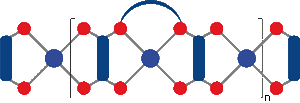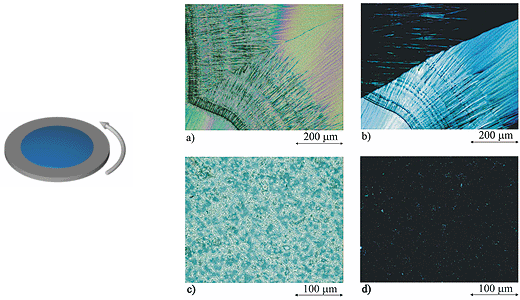 |
 |
Technische Universität Chemnitz
/ Naturwissenschaften
/ Physik
Organic Semiconductors |
|
||||||||
|
H I N T
Attention: This is a website with outdated content. It is for historical documentation purposes only.
The OHL Group has been part of Semiconductor Physics Group since September 2010.
Research Projects:
DFG Research Unit "Towards Molecular Spintronics"
BMBF "Kompetenznetzwerk für Nanosystemintegration: Anwendung von Nanotechnologien für energieeffiziente Sensorsysteme"
Magnetic and magneto-optical studies of transition metal complexes:
Molecule based magnetic materials are of potential interest for a new generation of magneto-optical data storage elements. Transition metal complexes are promising candidates due to the many possibilities of varying their structure and thereby influencing their physical and chemical properties, e. g.:
Sketch molecular complex
|

|
In collaboration with the department of chemistry we synthesize such compounds and perform electron paramagnetic resonance (EPR), magnetic susceptibility, and magneto-optic Kerr effect (MOKE) investigations. Technological applications of magnetic molecules such as magneto-strictive sensors, spintronic components, and magneto-optical data processing units may arise when thin films, multi-layers or nanostructures with well defined physical properties can be produced in a controlled way. For many molecules showing magnetic activity, spin coating is the only method that allows to obtain thin films on substrates. We investigate the influence of the functional groups on the solubility of the molecular complexes and hence on the quality of the spin coated films.
| Fig. 3: Principle of spin coating (left) and Polarization microscopy images of a tri-nuclear Cu complex on Si(111)/SiO2 using unpolarized (a)/(c) and polarized light (b)/(d), respectively, for a film produced by dipping into a solution (a)/(b) and a sample spin coated with 1000 rpm (c)/(d). |

|
1) B. Bräuer, T. Rüffer, R. Kirmse, J. Griebel, F. Weigend, G. Salvan, Spin density distribution in oxamato-type transition metal complexes, Polyhedron, 26 (9-11) (2007) 1773.
2) B. Bräuer, D. R. T. Zahn, T. Rüffer, G. Salvan, Deposition of thin films of a transition metal complex by spin coating, Chemical Physics Letters, 432, 2006, 226.
3) T. Rüffer, B. Bräuer, F. Eyaane Meva, B. Walfort, G. Salvan, A. K. Powell, I. J. Hewitt, L. Sorace, A. Caneschi, Synthesis, characterization, and magnetic properties of new homotrinuclear bis(oxamato) copper(II) complexes with an asymmetric central N,N'-bridge Inorganica Chimica Acta 360 (12), (2007) 3777.
Heterostructures of organic semiconductors and magnetic metals:
Organic materials have great application potential in the field of spintronic devices, since pure organic layers or organic layers doped with magnetic nanoparticles can be used to mediate or control a spin-polarized signal. One research direction of the Organic Semiconductors group is the investigation of the formation of transition metal nanoparticles in organic matrices and their structural and magnetic properties. Another research focus lies in the understanding the role played by the properties of an organic film on the growth and magnetic properties of a top transition metal electrode in structures similar to those met in vertical spin valves.
| Fig. 3: Tuning of the MOKE signal of a metal/organic heterostructure by changing the organic film thickness |

|
1) Wen Li, Michael Fronk, Hartmut Kupfer, Steffen Schulze, Michael Hietschold, Dietrich R. T. Zahn and Georgeta Salvan, Aging of Rubrene Layers in Ni/Rubrene Heterostructures Studied by Magneto-Optical Kerr Effect Spectroscopy , J. Am. Chem. Soc., 132 (2010), 5687?5692.
2) Björn Bräuer, Yana Vaynzof, Wei Zhao, Antoine Kahn, Wen Li, Dietrich R.T. Zahn, César de Julián Fernández, Claudio Sangregorio, and Georgeta Salvan, Electronic and magnetic properties of Ni nanoparticles embedded in various organic semiconductor matrices , J. Phys. Chem. B, 113 (2009) 4565.
Magneto-optical properties of organic semiconductors:
Organic molecules are known since decades to change the polarization state of the light transmitted through a solution or a film under applied magnetic field. In the view of possible applications in the emerging field of organic-based spintronic devices, however, the magneto-optical activity of molecular thin films in reflection mode when deposited on opaque substrates is of higher interest. The Organic Semiconductors group showed that molecules from the class of phthalocyanines exhibit a significant MOKE signal at room temperature, only two to three orders of magnitude lower than that of ferromagnetic systems. The MOKE spectra in the visible to near ultraviolet spectral range can be exploited to determine the magneto-optical material constant and subsequently the orientation of the molecules with respect to the substrate in the thin films.
| Fig. 4: Energy dispersion of the magneto-optical Voigt constant of CuPc for three groups of thin films having different molecular orientation. |

|
1) M. Fronk, B. Bräuer, J. Kortus, O.G. Schmidt, D.R.T. Zahn and G. Salvan, Determination of the Voigt constant of phthalocyanines by magneto-optical Kerr-effect spectroscopy, Phys. Rev. B, 79 (2009) 235305.
2) Björn Bräuer, Michael Fronk, Daniel Lehmann, Dietrich R. T. Zahn, and Georgeta Salvan, Magneto-optical Kerr effect spectroscopy: a sensitive tool for investigating the molecular orientation in organic semiconductor films, J. Phys. Chem. B, 113 (2009), 14957.
| Impressum / Imprint | TUC / NW / Ph -- OHL | HLPH |